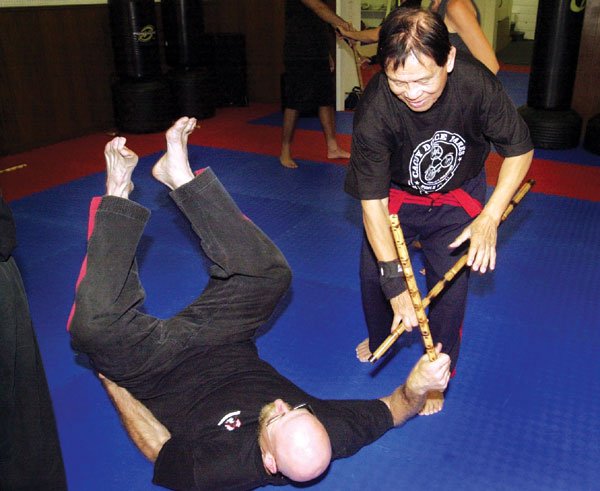Tobias Farmer knew he had no chance.
Sure, the Gilroyan is a black belt in three different forms of
tae kwondo and is the head instructor of Rok’s Tae Kwon Do in
Gilroy. Plus, his sparring partner had just celebrated his birthday
the day before. His 84th birthday.
Tobias Farmer knew he had no chance.
Sure, the Gilroyan is a black belt in three different forms of tae kwondo and is the head instructor of Rok’s Tae Kwon Do in Gilroy. Plus, his sparring partner had just celebrated his birthday the day before. His 84th birthday.
But time after time, Farmer was sent to the mat and left rubbing out the pain in his wrist. Such is the experience of going face-to-face with Filipino martial arts legendary Grandmaster Ciriaco “Cacoy” Canete.
“I’m the dummy,” Farmer said.
However, according to other martial arts students, that’s not such a bad thing.
“It’s an honor to be called a dummy for a grandmaster,” said Manuel Francisco, who also is a high-rated black belt instructor from San Jose.
Both of the instructors were sent to the mat over and over during the afternoon. It almost looked too easy for Canete, who with a minimum of moves would force their bodies to the ground and could control their movements.
“Once he has you wrist down and your elbow up, you’re done,” said Farmer. “If you don’t go down, your wrist will break.”
But for anyone who thought Farmer might just be taking it easy on a man nearly twice his age, he had a simply message.
“If you don’t think it’s real, step up to the plate,” he said.
Farmer and Francisco were two of the lucky group of martial arts students – with more than 500 years of experience between them – who were able to spend a day learning from the legendary Canete, who made a special appearance Saturday at Rok’s Tae Kwon Do, 7511 Monterey Road.
Canete, with 77 years of martial arts experience of his own, is a co-founder of the Doce Pares Eskrima Club in his home country of the Philippines in 1932, a 12-degree black belt and recently was named the most distinguished grandmaster of the year for 2003 by U.S. Martial Arts Association, which accepted him as an international inductee. He even has his own international fan club.
Dressed in a black shirt with a Doce Pares insignia on it and wearing blue warm-up pants with three thin red strips running down the side, Canete doesn’t exactly look like a man who is undefeated in more than 100 death matches – fights in which eskrimadors wear no protection and fight until one of them gives in (no one actually dies).
In fact, he just looked more like a guy joking around with friends. With thinning black hair with a bit of white along the edges, and a slow but steady walk when he’s not sparring, one would never think of Canete as a fighter. Instead, he looks like a fun-loving guy looking to tell you a joke – most of which aren’t fit to print.
But when Canete is on the mat, he doesn’t start laughing until his opponent is on the ground. Then he’ll be more than happy to tell them how he did it.
“No secrets … the only secrets I keep is secret lovers,” he joked.
Canete spends much of his time traveling around the country doing seminars like this one for students of the martial arts. When Farmer saw him do a seminar in South San Jose, he knew he had to have him back.
“I was so overwhelmed with Grandmaster Canete, that I had to train with him again,” he said.
Despite Canete’s busy schedule, Farmer asked Francisco to keep his eye out for any openings in his schedule. A seminar back East fell through, so Canete came to Gilroy.
“You really can’t put this into words,” Farmer said. “He’s an icon, a national treasure. It’s incredible, it’s a once in a lifetime opportunity. His lessons are valuable not only in here but in the real world. If we can take just a little out of what we learned today, we’ll be great people.”
Francisco agreed.
“He knows how to live life,” he said. “He’s a great role model for the young and the old.”
Canete began his studies in the martial arts when he was just 7 years old. He was trained by his older brother in boxing and Ju Jitsu. He learned the art form of eskrima in 1926, and a decade later he began to form his own style, called eskrido.
In 1932, he joined with 23 other martial artists from his country to form Doce Pares, meaning “Twelve Pairs.” The 24 fighters put their different styles together.
“Everybody had different ideas of what worked,” he said.
The young Canete was known as the group’s best fighter, and he practiced four hours every night as he continued to improve.
“No holidays for me,” he said. “I practiced three to four hours every day. I was preparing for war.”
That war was with an opposing eskrima group in his country. The two often clashed and called each other out to fight in death matches. No matter how bloody the fights got, part of the honor was not to go to police after a fight, and the local authorities also didn’t get involved with the matches.
Canete never challenged another fighter – the challenges always came to him – and he was involved in many famous fights with other eskrimadors.
“I beat all of them,” he said, his joking nature vanished just for a moment. “No exceptions.”
But while Canete never lost, he did undergo some viscous hits in his time.
“No doubt (I took hits),” he said. “Every time you get hit, you improve.”
Even at 84-years-old now, Canete continues to practice. He has two-hour, full-contact sparring sessions with men less than half his age multiple times a week. And the scary thing is that he’s still getting better.
“I’m still improving,” he said. “I’m just starting to climb the summit of eskrido. I’m climbing and climbing to the Everest of it.”














